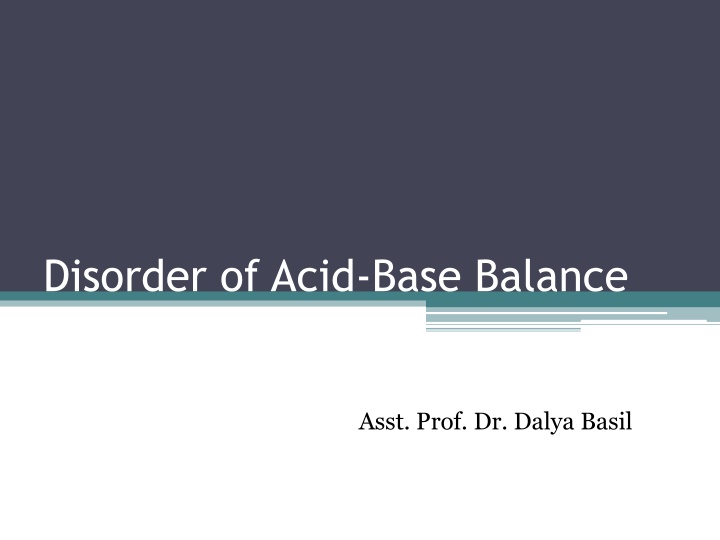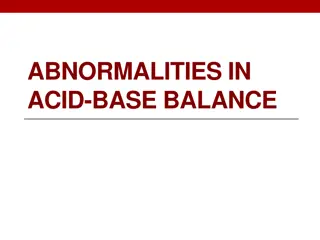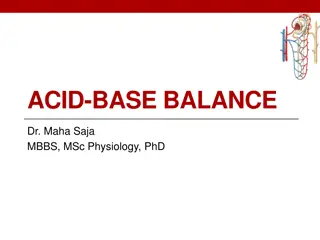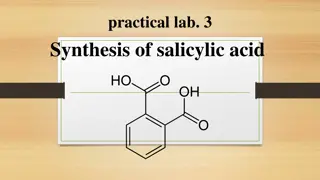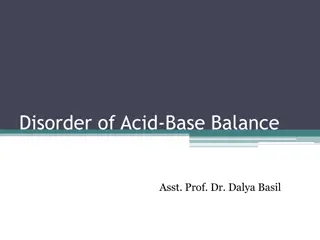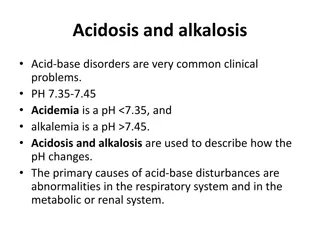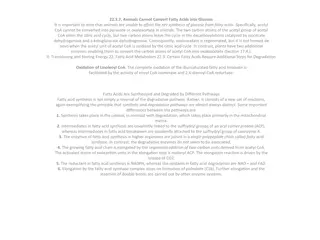Disorders of Acid-Base Balance
Disorders of acid-base balance encompass metabolic and respiratory disturbances resulting in pH alterations. Metabolic acidosis and alkalosis involve serum HCO3 levels, while compensatory mechanisms aim to maintain pH stability. Primary and compensatory changes in pH vary, with lungs and kidneys playing key roles in compensation. Metabolic acidosis, for instance, is characterized by reduced serum HCO3 levels and pH, with compensatory respiratory rate adjustments. Various causes can lead to metabolic acidosis, such as lactic acid accumulation.
Download Presentation

Please find below an Image/Link to download the presentation.
The content on the website is provided AS IS for your information and personal use only. It may not be sold, licensed, or shared on other websites without obtaining consent from the author.If you encounter any issues during the download, it is possible that the publisher has removed the file from their server.
You are allowed to download the files provided on this website for personal or commercial use, subject to the condition that they are used lawfully. All files are the property of their respective owners.
The content on the website is provided AS IS for your information and personal use only. It may not be sold, licensed, or shared on other websites without obtaining consent from the author.
E N D
Presentation Transcript
Disorder of Acid-Base Balance Asst. Prof. Dr. Dalya Basil
Disorders of Acid-Base Balance There are two types of acid-base disorders: metabolic and respiratory. Metabolic disorders produce an alteration in the serum HCO3 concentration and results from the addition or loss of nonvolatile acid or alkali to or from the extracellular fluids. A reduction in pH due to a decrease in HCO3 is called metabolic acidosis, and an elevation in pH due to increased HCO3 levels is called metabolic alkalosis.
Disorders of Acid-Base Balance Acidosis and alkalosis typically involve a primary or initiating event and a compensatory or adaptive state that results from homeostatic mechanisms that attempt to correct or prevent large changes in pH. For example, a person may have a primary metabolic acidosis as a result of overproduction of ketoacids and respiratory alkalosis because of a compensatory increase in ventilation.
Primary Versus Compensatory Changes in pH Compensatory mechanisms provide a means to control pH when correction is impossible or cannot be immediately achieved. Compensation requires the use of mechanisms that are different from those that caused the primary disorder.
Primary Versus Compensatory Changes in pH For example, the lungs cannot compensate for respiratory acidosis that is caused by lung disease, nor can the kidneys compensate for metabolic acidosis that chronic kidney disease. The body can, however, use renal mechanisms to compensate for respiratory-induced changes in pH, and it can use respiratory mechanisms to compensate for metabolically induced changes in acid-base balance. occurs because of
Metabolic Acidosis Metabolic acidosis involves a decreased serum HCO3 concentration along with a decrease in pH. In metabolic acidosis, the body compensates for the decrease in pH by increasing the respiratory rate in an effort to decrease PCO2 and H2CO3 levels. The PCO2 can be expected to fall by 1 to 1.5 mm Hg for each 1 mEq/L fall in HCO3.
Causes of Metabolic Acidosis 1- Accumulation of lactic acid Acute lactic acidosis, which is one of the most common types of metabolic acidosis, develops when there is excess production or diminished removal of lactic acid from the blood. Lactic acid is produced metabolism of glucose. Most cases of lactic acidosis are caused delivery, as in shock or cardiac arrest. by the anaerobic by inadequate oxygen
Causes of Metabolic Acidosis 2- Excess production of ketoacids Ketoacids produced in the liver from fatty acids, are the source of fuel for many body tissues. An overproduction of ketoacids occurs when carbohydrate stores are inadequate or when the body cannot use available carbohydrates as a fuel. Under these conditions, fatty acids are mobilized from adipose tissue and delivered to the liver, where they are converted to ketones. Ketoacidosis develops when ketone production by the liver exceeds tissue use.
Causes of Metabolic Acidosis 3- Decreased Renal Function Chronic kidney disease is the most common cause of chronic metabolic acidosis. The kidneys normally conserve HCO3 and secrete H ions into the urine as a means of regulating acid- base balance. In chronic kidney disease, there is loss of both glomerular and tubular function, with retention of nitrogenous wastes and metabolic acids. In a condition called renal tubular acidosis, glomerular function is normal, but the tubular secretion of H or reabsorption of HCO3 is abnormal
Causes of Metabolic Acidosis 4- Increased Bicarbonate Losses Increased HCO3 bicarbonate-rich conservation of HCO3 by the kidney. Intestinal secretions have a high HCO3 concentration. Consequently, excessive loss of HCO3 occurs with severe diarrhea; small-bowel, pancreatic, or biliary fistula drainage; and intestinal suction. In diarrhea of microbial origin, HCO3 is also secreted into the bowel as a means of neutralizing the metabolic acids produced by the microorganisms causing the diarrhea. losses body occur fluids with or the loss impaired of with
Manifestation of Metabolic Acidosis The manifestations of metabolic acidosis fall into three categories: signs and symptoms of the disorder causing the acidosis, changes in body function related to recruitment mechanisms, and alterations in cardiovascular, neurologic, and musculoskeletal function resulting from the decreased pH. Metabolic acidosis is characterized by a decrease in serum pH (7.35) and HCO3 levels (24 mEq/L) due to HCO3 loss. Acidosis compensatory increase in respiratory rate with a decrease in PCO2. of compensatory typically produces a
Manifestation of Metabolic Acidosis Metabolic acidosis is seldom a primary disorder; it usually develops during the course of another disease. The manifestations of metabolic acidosis frequently are superimposed on the symptoms of the contributing health problem. With diabetic ketoacidosis, which is a common cause of metabolic acidosis, there is an increase in blood and urine glucose and a characteristic smell of ketones to the breath. In metabolic acidosis that accompanies chronic kidney disease, blood urea nitrogen levels are elevated and other tests of renal function yield abnormal results.
Metabolic Alkalosis Metabolic alkalosis is a systemic disorder caused by an increase in serum pH due to a primary excess in HCO3. It is reported to be the second most common acid-base disorder in hospitalized adults, accounting for about 32% of all acid-base disorders.
Causes of Metabolic Alkalosis Metabolic alkalosis can be caused by factors that generate a loss of fixed acids or a gain of bicarbonate and those that maintain the alkalosis by interfering with excretion of the excess bicarbonate. They include: (1) a gain of base via the oral or intravenous route (2) loss of fixed acids (3) maintenance of the increased bicarbonate levels by contraction of the ECF volume, hypokalemia, and hypochloremia.
Manifestation of Metabolic Alkalosis Metabolic alkalosis is characterized by a serum pH above 7.45, serum HCO3 above (29 mmol/L), and base excess above (3 mmol/L). Persons with metabolic alkalosis often are asymptomatic or have signs related to ECF volume depletion or hypokalemia. Neurologic signs (e.g., hyperexcitability) frequently with metabolic alkalosis than with other acid- base disorders because HCO3 enters the cerebrospinal fluid (CSF) more slowly than CO2. When neurologic manifestations do occur, as in acute and severe metabolic alkalosis, they include mental confusion, hyperactive reflexes, tetany. occur less
